Author
Zigurat Global Institute of Technology
Blog / Disruptive Technologies
Categories
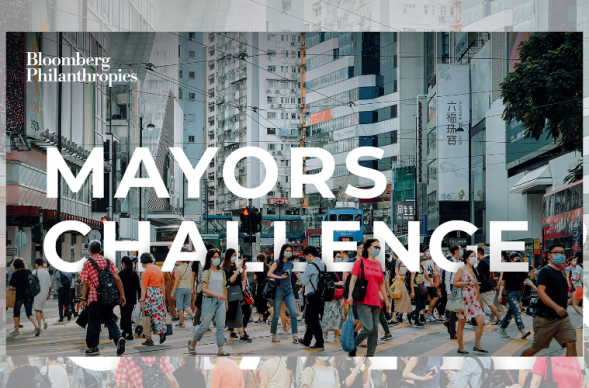
 Mayors Challenge Example:
Columbus, USA: providing last-mile WiFi access to underserved communities.
"Columbus faces an increasing digital-divide challenge, and one in four students were unable to fully participate in class when schools shifted to remote learning as a result of COVID-19. The city is proposing to expand last-mile wireless access to homes that are currently underserved by installing base stations on city buildings."
Mayors Challenge Example:
Columbus, USA: providing last-mile WiFi access to underserved communities.
"Columbus faces an increasing digital-divide challenge, and one in four students were unable to fully participate in class when schools shifted to remote learning as a result of COVID-19. The city is proposing to expand last-mile wireless access to homes that are currently underserved by installing base stations on city buildings."
 Mayors Challenge Example:
Daegu, South Korea: digital permissioning to bring new life to urban spaces.
"Daegu is facing economic stagnation and population decline, and prior revitalization efforts—top-down infrastructure and industry development initiatives—haven’t worked. The city is proposing a digital licensing platform that permits citizens to utilize urban space for civic activities that will promote social, cultural, and civic infrastructure as well. "
Mayors Challenge Example:
Daegu, South Korea: digital permissioning to bring new life to urban spaces.
"Daegu is facing economic stagnation and population decline, and prior revitalization efforts—top-down infrastructure and industry development initiatives—haven’t worked. The city is proposing a digital licensing platform that permits citizens to utilize urban space for civic activities that will promote social, cultural, and civic infrastructure as well. "
 Mayors Challenge Example:
Pune, India: Building the foundation for an all-electric-vehicle future.
"Among Indian cities, Pune has some of the highest rates of vehicle ownership, and vehicles contribute nearly 25 percent of particulate pollution in the city. To increase early adoption of electric vehicles (EVs), Pune proposes to prepare a city EV-readiness plan and establish an EV fund that incentivises use."
Mayors Challenge Example:
Pune, India: Building the foundation for an all-electric-vehicle future.
"Among Indian cities, Pune has some of the highest rates of vehicle ownership, and vehicles contribute nearly 25 percent of particulate pollution in the city. To increase early adoption of electric vehicles (EVs), Pune proposes to prepare a city EV-readiness plan and establish an EV fund that incentivises use."
 Mayors Challenge Example:
Lusaka, Zambia: Incentivise the repurposing of trash into needed products.
"Lusaka's lack of a comprehensive waste-management system has resulted in widespread poor hygiene and illnesses. The city has developed the Waste2Cash project, which will encourage sustainable waste management by converting the waste into other usable products."
Mayors Challenge Example:
Lusaka, Zambia: Incentivise the repurposing of trash into needed products.
"Lusaka's lack of a comprehensive waste-management system has resulted in widespread poor hygiene and illnesses. The city has developed the Waste2Cash project, which will encourage sustainable waste management by converting the waste into other usable products."
 Glasgow, UK: Unleashing a neighbourhood-level participatory approach to community well-being.
"More than a quarter of children in Glasgow are living in poverty; at the same time, the city is struggling to grapple with the impacts of climate change. The city is proposing to upskill its residents—especially those in impoverished areas—with design and innovation skills and link them with industry, business, and academia to launch enterprising solutions to eradicate poverty and address the climate emergency."
Glasgow, UK: Unleashing a neighbourhood-level participatory approach to community well-being.
"More than a quarter of children in Glasgow are living in poverty; at the same time, the city is struggling to grapple with the impacts of climate change. The city is proposing to upskill its residents—especially those in impoverished areas—with design and innovation skills and link them with industry, business, and academia to launch enterprising solutions to eradicate poverty and address the climate emergency."
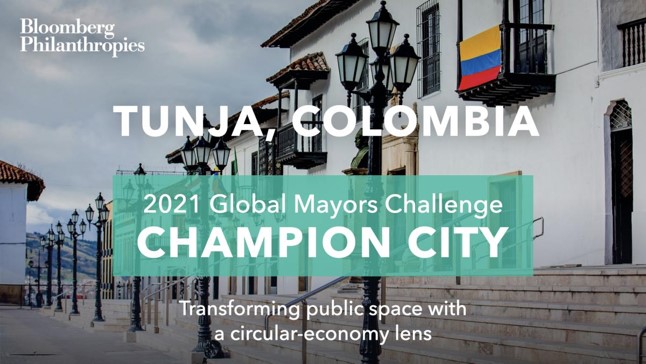 Mayors Challenge Example:
Tunja, Colombia: Transforming public space with a circular economy lens.
"In Tunja, unemployment increased from 14.3 percent in 2019 to 20.2 percent in 2020 as a result of the pandemic. The city proposes a new circular economy jobs program. Through recycling centers, residents will be employed to generate indoor and outdoor furniture for public spaces such as libraries and parks, all from cardboard waste."
Mayors Challenge Example:
Tunja, Colombia: Transforming public space with a circular economy lens.
"In Tunja, unemployment increased from 14.3 percent in 2019 to 20.2 percent in 2020 as a result of the pandemic. The city proposes a new circular economy jobs program. Through recycling centers, residents will be employed to generate indoor and outdoor furniture for public spaces such as libraries and parks, all from cardboard waste."
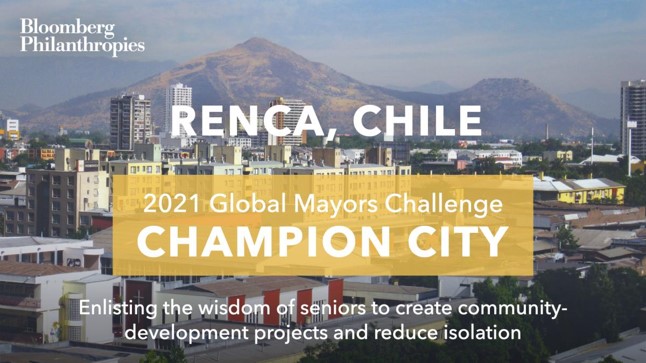 Renca, Chile: Enlisting the wisdom of seniors to create community development projects and reduce isolation.
"In Renca, more than 65 percent of seniors live in poverty with low pensions or precarious employment, and many are suffering increased social isolation as a result of the pandemic. The city proposes to establish an innovation hub that facilitates seniors to design new community development projects—harnessing the talents and perspectives of the elderly community."
Renca, Chile: Enlisting the wisdom of seniors to create community development projects and reduce isolation.
"In Renca, more than 65 percent of seniors live in poverty with low pensions or precarious employment, and many are suffering increased social isolation as a result of the pandemic. The city proposes to establish an innovation hub that facilitates seniors to design new community development projects—harnessing the talents and perspectives of the elderly community."
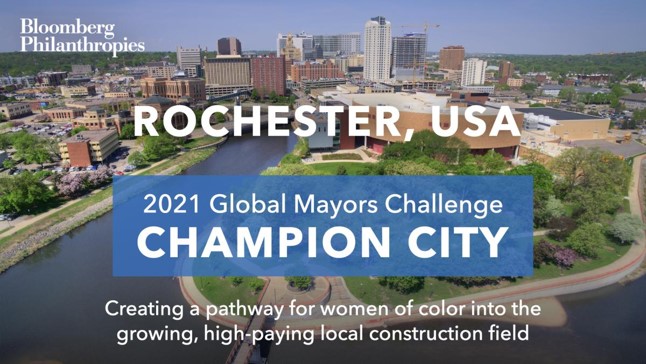 Mayors Challenge Example:
Rochester, USA: Creating a pathway for women of colour into the growing, high-paying local construction field.
"In Rochester, Minn., 40 percent of Black residents live in poverty, and the level of unemployment among BIPOC (Black, Indigenous, and People of Color) women is far higher than among any other demographic group. The city proposes to engage BIPOC women, employers, and labor associations to design pathways for increased participation in Rochester's growing construction industry, by focusing on education, training, hiring, and work culture interventions."
Mayors Challenge Example:
Rochester, USA: Creating a pathway for women of colour into the growing, high-paying local construction field.
"In Rochester, Minn., 40 percent of Black residents live in poverty, and the level of unemployment among BIPOC (Black, Indigenous, and People of Color) women is far higher than among any other demographic group. The city proposes to engage BIPOC women, employers, and labor associations to design pathways for increased participation in Rochester's growing construction industry, by focusing on education, training, hiring, and work culture interventions."
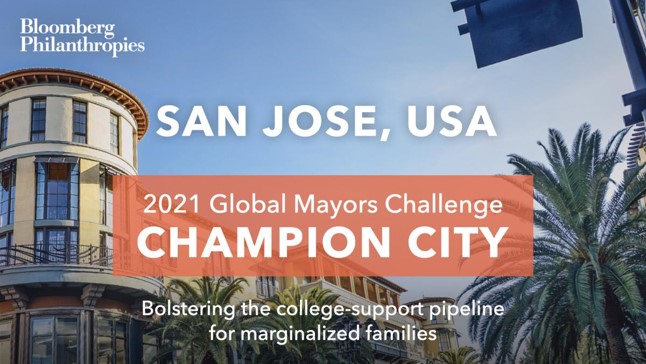 Mayors Challenge Example:
San Jose, USA: Bolstering the college support pipeline for marginalised families.
"The cost of living in San Jose is the sixth highest in the country. Yet fewer than half of the residents over age 25 have acollege degree, which makes it hard for many to earn sufficient income. The city is proposing an engagement program to help families earn scholarship dollars toward their children's education through virtual or in-person skills training. Not only would students build funds for college, but parents and families would also gain the knowledge of how to navigate the application process."
Mayors Challenge Example:
San Jose, USA: Bolstering the college support pipeline for marginalised families.
"The cost of living in San Jose is the sixth highest in the country. Yet fewer than half of the residents over age 25 have acollege degree, which makes it hard for many to earn sufficient income. The city is proposing an engagement program to help families earn scholarship dollars toward their children's education through virtual or in-person skills training. Not only would students build funds for college, but parents and families would also gain the knowledge of how to navigate the application process."
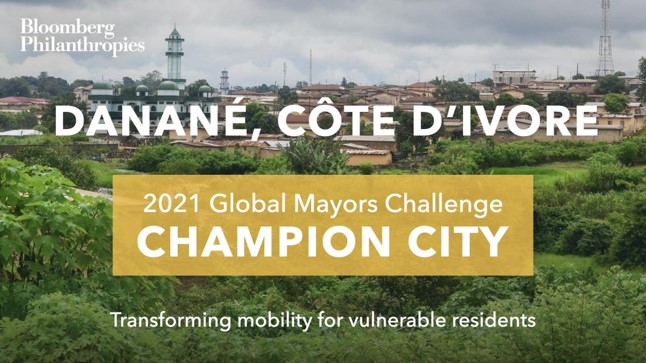 Danané, Ivory Coast: Transforming mobility for vulnerable residents.
"Transportation in Danané is dominated by old, extremely polluting taxis, and the city lacks affordable and eco-friendly transportation options. The city will pilot a fleet of solar- and electric-powered tricycle taxis and provide free rides for expectant mothers to prenatal and postnatal appointments. The cross-subsidy model provides financial sustainability as it allows the income from the transport of goods and other persons to subsidize the cost of transporting mothers."
As I mentioned at the outset, this is not intended to be a comprehensive taxonomy, just an attempt to identify some common patterns that are in play within smart city projects. It might also be argued by some that many of these examples are not strictly smart city projects, as they don't rely on technologies that are usually associated with the field. However, we who work on Zigurat’s Global Smart City Management masters programme take a similar view to Bloomberg Philanthropies, that urban innovation, 'smart' or otherwise, is about the application of all of the tools at our disposal to address urban challenges, whether they are technological, economic, social, political or administrative. The overarching approach is to engage with communities and consider every lever available.
My hope is that these examples help us to think about these things, and spark more conversation. By all means contribute your thoughts in comments, and/or get in contact with me via LinkedIn or Twitter.
Main Image Source: Bloomberg Cities Network
Author: Chrys Dymond, Director of the Master's in Global Smart City Management of Zigurat.
Danané, Ivory Coast: Transforming mobility for vulnerable residents.
"Transportation in Danané is dominated by old, extremely polluting taxis, and the city lacks affordable and eco-friendly transportation options. The city will pilot a fleet of solar- and electric-powered tricycle taxis and provide free rides for expectant mothers to prenatal and postnatal appointments. The cross-subsidy model provides financial sustainability as it allows the income from the transport of goods and other persons to subsidize the cost of transporting mothers."
As I mentioned at the outset, this is not intended to be a comprehensive taxonomy, just an attempt to identify some common patterns that are in play within smart city projects. It might also be argued by some that many of these examples are not strictly smart city projects, as they don't rely on technologies that are usually associated with the field. However, we who work on Zigurat’s Global Smart City Management masters programme take a similar view to Bloomberg Philanthropies, that urban innovation, 'smart' or otherwise, is about the application of all of the tools at our disposal to address urban challenges, whether they are technological, economic, social, political or administrative. The overarching approach is to engage with communities and consider every lever available.
My hope is that these examples help us to think about these things, and spark more conversation. By all means contribute your thoughts in comments, and/or get in contact with me via LinkedIn or Twitter.
Main Image Source: Bloomberg Cities Network
Author: Chrys Dymond, Director of the Master's in Global Smart City Management of Zigurat.

Zigurat Global Institute of Technology